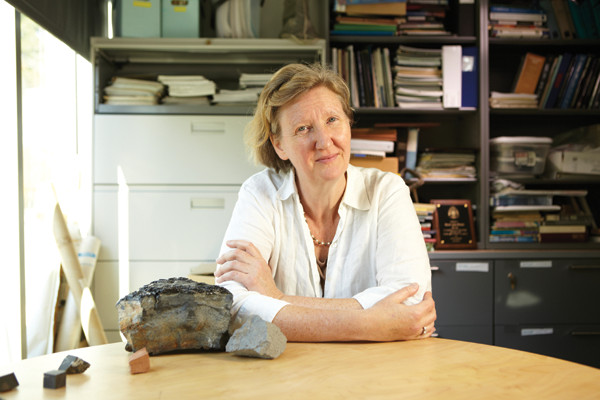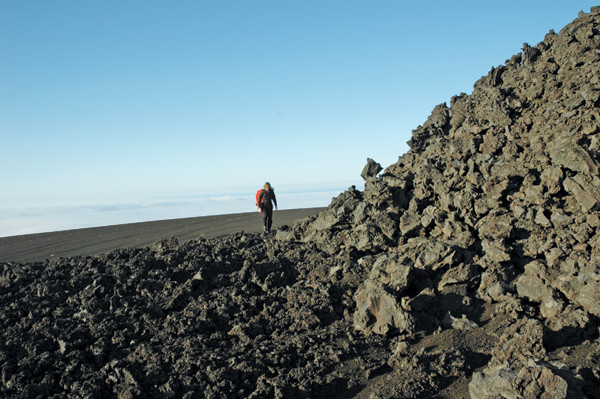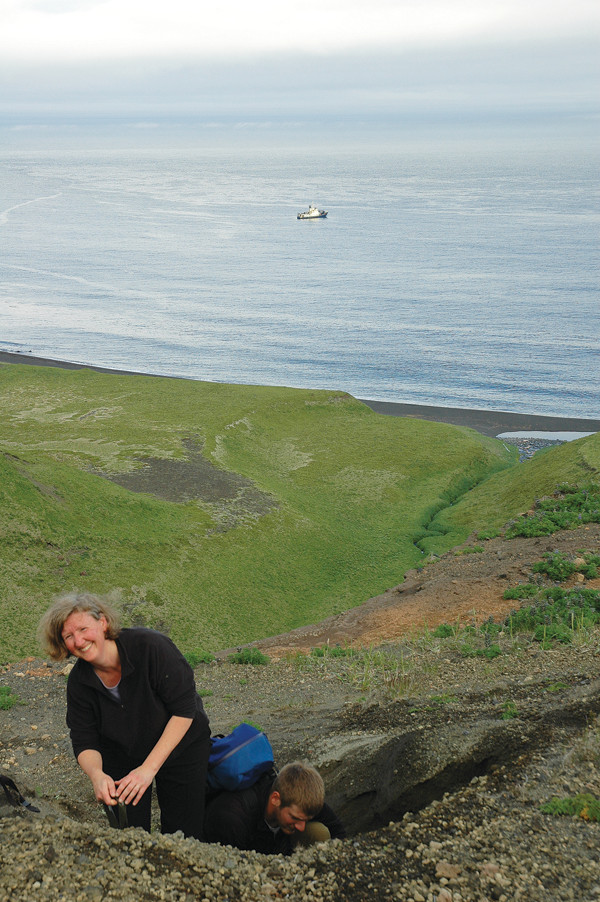
by Timothy Oleson Thursday, December 18, 2014

Terry Plank, a geochemist and volcanologist at Columbia University, is a recipient of a 2012 MacArthur Foundation "genius grant." Credit: Courtesy of the John D. & Catherine T. MacArthur Foundation.
“You’re a genius! Now here’s half a million dollars to use however you please.”
That, in essence, was what geochemist and volcanologist Terry Plank was told when she received a surprising phone call early last October. The voice on the other end of the line was that of Robert Gallucci, president of the MacArthur Foundation, who was calling to inform her that she’d been selected to receive one of the foundation’s 23 fellowships — the so-called “genius grants” — for 2012. The prestigious, “no strings attached” grants award $500,000 over five years to innovative individuals to allow them the flexibility to pursue creative, often otherwise out-of-reach interests.
A professor in the Department of Earth and Environmental Sciences and the Lamont-Doherty Earth Observatory at Columbia University since 2008, Plank has spent more than two decades decoding what volcanic rocks can tell us about subducting tectonic plates, the cycling of water and other materials through Earth’s interior, and the hazards posed by magmatic eruptions. Her research has taken her to some of the world’s most remote vantage points, and has allowed her to pursue her passions: figuring out what makes Earth tick and, quite simply, being outside.
EARTH’s Timothy Oleson spoke with Plank after she’d weathered the initial MacArthur media storm to ask her about where her work is heading, what her family thinks of her newfound celebrity, and the joys of being a geologist.
TO: Does your interest in studying volcanoes have anything to do with the fact that “volcanologist” is probably one of the coolest-sounding job titles you can have?
TP: I didn’t become a geologist to study volcanoes. I was interested in the “really boring rocks” around Delaware and New Hampshire. But when I came to graduate school at Columbia, there was a global emphasis on studying plate tectonics. Even then, I think I was mostly interested in just using magmas as a remote-sensing tool. Magmas carry in them all sorts of information — their temperature and their pressure of formation, for example — like a genetic code. My emphasis has always been to study how the tectonic plates function and create new crust and create the world we stand on. It’s only been recently that I’ve been interested in volcanoes as exciting erupting entities.

Plank hikes through gnarled and jagged volcanic rocks on remote Seguam Island in Alaska's Aleutian Islands. Credit: Brad Singer, courtesy of Terry Plank.
TO: Why is it important to understand volcanoes?
TP: All the questions about how plate tectonics work in our planet are what initially interested me, with no really direct application to anybody’s lives. But I don’t think it’s hard for anybody to imagine that this is an important issue, not just for people who live around volcanoes, but really globally. If you think of the Iceland eruption [in 2010], which shut down European airspace for weeks, that’s a problem that affected millions of people. We’d kind of like to know if there are other volcanoes in Iceland that can do that as well. Questions like that seem important, I think, in addition to monitoring volcanoes and knowing how to get people out of the way when they do erupt.
TO: You have said that, over the course of billions of years, oceans’ worth of water may have cycled through subduction zones and the deep earth. That’s mind-boggling!
TP: It is such a crazy phenomenon. If you add up how much water is being carried into the mantle [at a given time] by subducting plates — sediments on the seafloor have water bound in their minerals and the seafloor itself has water bound in it — it’s not that much, a few weight percent. But if you carry a few weight percent water [over time] … that’s about enough to have subducted the entire ocean in 1 or 2 billion years. Our planet is 4 and a half billion years old [and we still have oceans], so the water has to come back [to the surface] somehow.
That’s why we’re interested in developing ways … to sense how hot the subducting plate is in different places, and therefore to tell how much water would either be lost from the subduction zone and come back to the surface potentially, or get carried into the deeper earth. We still don’t quite know what the balance of that is.
TO: Is it true that you had no idea that you had even been nominated for a MacArthur Foundation grant?
TP: I had no idea. It’s a process that’s veiled in great secrecy. Nobody is ever supposed to tell you if you’ve been nominated. Nobody is supposed to confess that they wrote you letters of support. It really was just a phone call that came out of thin air and changed what I’m going to do for the next five years, and probably my whole career.
I’m talking to the president of the MacArthur Foundation on the phone, and he says, “We don’t really care what you do with this. If you decide you’re sick of geology and go become a concert violinist, that’s fine with us.” OK, well I’m not really going to be a concert violinist. I’ll spend [the award money] on research more or less. The kinds of research that are hard to fund otherwise: seed grants for crazy ideas or small amounts of money to go do a pilot project somewhere. That’s as far as I’ve gotten [in planning].

Plank samples erupted lavas on Seguam with Brian Jicha of the University of Wisconsin at Madison. Credit: Brad Singer, courtesy of Terry Plank.
TO: As someone who I’m sure is accustomed to the usual grant process of putting together big applications and having to report on how you’re using funds and what’s been accomplished, how excited are you when you hear “no strings attached”?
TP: It’s awesome! The most difficult and challenging thing that we do is writing proposals … It’s not an easy process. If I look back on the cool science that I’ve done, almost none of it has happened that way.
The most interesting and creative work that I’ve done has just happened because I’ve had a spare month when I had time to think about something that I wasn’t even funded to do, or to mess around with somebody else’s data, or to travel and talk to other colleagues and get other ideas. There is a lot to do with “no strings attached” money that I hope will lead to some other useful [projects].
TO: What was your family’s reaction when you received the award?
TP: My mother was very proud, of course. The amazing thing is that this is so public … It’s just splashed all over the papers. I literally got 400 emails in one day; it was crazy. And my mom and sister and brother all had people contacting them, asking, “Wow, is that your sister?” It’s great to hear from people I haven’t heard from in a long time.
My son makes fun of me now, of course, whenever I do something stupid. He says, “Yeah mom, you’re a genius.” You know it’s going to be years of genius jokes for everybody. … I make lots of mistakes, and I’m not a genius. So that’s kind of the most embarrassing part of it.
TO: You’ve traveled and done fieldwork all over the place. Is there one location that’s been a favorite and to which you’d like to return?
TP: I would love to get back to the Aleutian Islands in Alaska. It’s just such a beautiful place, and so remote, and kind of desperate. I’ve been twice. Once was to the island of Akutan, which is one of the islands where the guys on that show, “Deadliest Catch,” unload their [crab] catch. It’s one of the world’s largest on-land fish-processing plants, I think, but it’s also sitting on a big volcano.
And we went way out farther to another little island, Seguam, which we could only get to by hitchhiking a ride on a U.S. Fish and Wildlife vessel that was out counting birds. That was pretty cool. [We took a] Zodiac ashore and hiked up the volcano. We sampled lava and eruptive products of the last 10,000 years.
TO: When you have a few spare minutes, are there any hobbies you like to pursue outside of research and teaching?
TP: I like to throw big dinner parties, so I do that a lot. I like to entertain. I like to be sociable. Like most geologists … I like to be outside, like to drink beer [laughs]. It’s why we’re geologists; we’re scientists who have fun!
TO: Is that your sales pitch to get people interested in geology?
TP: We’ve had a bunch of chemists who’ve actually defected into earth science because … they realize they could do much more exciting projects that get them outside or that are topical and timely.
I actually don’t think that it requires a whole lot of sales pitching, more than just getting the word out about what we do. I guess my main way of getting the message out is through teaching. I was also on a History Channel show once about the Mariana Trench, but it was kind of terrifying to be on TV. I don’t know if I want to do that again.
© 2008-2021. All rights reserved. Any copying, redistribution or retransmission of any of the contents of this service without the expressed written permission of the American Geosciences Institute is expressly prohibited. Click here for all copyright requests.